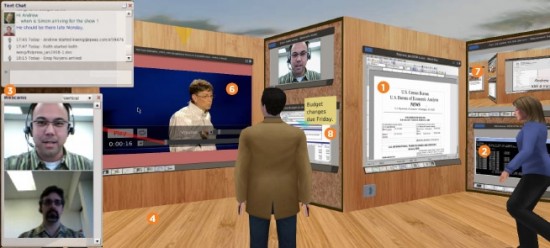Enterprise virtual world vendor added support for the Microsoft Sharepoint service, the company announced today.
Teleplace is one of the leading providers of enterprise-grade, behind-the-firewall, fully immersive virtual collaborative environments. It counts “hundreds” of corporations as customers – some of them big names, including Chevron, BP, Lockheed, Intel, and Fidelity. In addition, the company has a strong presence in the government and military sectors, counting the US Army, Navy, and Air Force as customers. Teleplace Inc. used to be Qwaq Inc.
According to company CEO Greg Nuyens, Teleplace already had support for Microsoft’s Active Directory — which means that user accounts could be created automatically based on corporate directories. With the new release, users can access documents stored in Sharepoint repositories and work on them collaboratively — on both Macs and Windows PCs — inside the Teleplace virtual environments.
Sharepoint is widely used in corporate environments to make sure that there aren’t different versions of the same document floating around confusing things. Instead, documents reside in the Sharepoint repository. Employees check documents out, make changes, and check them back in — and multiple people can’t work on one document at once, ensuring that the editing process is smooth and orderly.

If multiple people need to work on the same document they can either take turns editing it, stand around the same computer — or, now, log into a Teleplace virtual meeting space and edit the document there.
If a document has access restrictions on it, the user who brings in the document must have access rights to it. But all the other attendees in the same meeting room can then piggy back on those rights. When that user leaves, all the attendees lose the ability to access the document — unless they are able to check it out on their own.

This is similar to someone coming into a meeting, opening up their laptop, and showing a document, and then taking that laptop away with them when they leave, Nuyens explained.
Additional security is offered by the fact that Teleplace secures its spaces on a room-by-room basis. A user who doesn’t have permission to enter a particular room can’t see into it from the room next door, or hear anything that is said.
Another feature of the new release, which is version 3.5, is multiple-domain support. Large corporations often have their corporate directories across multiple domains. Previously, Teleplace users couldn’t be added automatically if they were in a different domain — or deleted automatically after they had left the company.
Teleplace has also improved its in-world building tools.
Like most enterprise-grade virtual world platforms, Teleplace supports the import of Collada-format 3D objects, allowing companies to use professional design software to create their virtual environments. This also allows them to import objects from engineering systems as well. But Teleplace has also offered some Second Life-style in-world building tools, allowing users to move objects around from inside the virtual environment, or create simple objects while inside the virtual world.
“Part of the appeal of virtual worlds is that we can do things collaborative on the fly,” said Nuyens. “You can talk about the layout of a booth in a trade show, or lay out the office walls.”
Users can now create new types of objects, group objects together, and undo actions on groups of objects.
Another improvement is for those users who use the built-in microphones on their computers instead of headsets. This normally leads to an echo effect. With the new release, if they’re using Vista or Windows 7, the echo effect will be automatically canceled out.
“Many people can now speak and not have any configuration issues,” he said.
Another improvement is the ability to send video from one room to another. Teleplace has always had the ability to pull in video from the outside — to put a life presentation, for example, on an wall inside a meeting room, or to put a Webcam stream in place of an avatar’s head. And Teleplace has been able to Webcast, sending video and audio of live meetings out to a website, so that those people who can’t attend an event virtually can see still what’s going on.
Now, this video stream can be sent from one virtual room to another. One use is to create a control room — or a security room — with monitors showing what’s going on in different locations. Another use is to broadcast a live virtual presentation to multiple virtual locations.
“It’s a powerful way for people to create spaces,” Nuyen said. “We’re getting a nice reaction to this, particularly from larger customers.”
- Kitely Mega Worlds on sale for $90 per month - July 19, 2024
- OpenSim regions up, actives down with summer heat - July 15, 2024
- People think AIs are conscious. What could this mean for bots in OpenSim? - July 12, 2024
